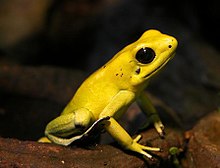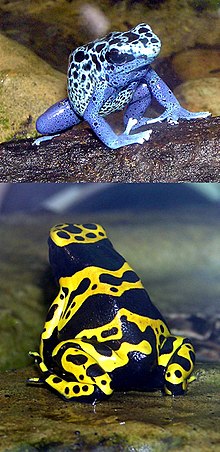Poison Dart Frogs (Dendrobatidae), also called poison arrow frogs, are native to Central and South America and can produce some of the world's most toxic poisons (batrachotoxins). BBC Earth calls these cute little guys "the most poisonous animals alive." The amphibians got their name because some South American indigenous tribes use their secretions to poison their darts and arrows.
 |
| The deadly golden poison arrow frog |
The frogs are poisonous, but not venomous. Their poison is not injected into victims, like snake venom, but is produced by glands in the frog's skin as a protective device. Native peoples extract it through slow-cooking the skin over a fire. The rendered secretions are potent for several years after harvesting. The toxin prevents victim's nerves from transmitting impulses, leaving the muscles in an inactive state of contraction. This can lead to heart failure.
 But not all frogs of the family are poisonous, and only three species are seriously dangerous to humans. The most deadly species is the golden poison arrow frog (Phyllobates terribilis). The poison in one frog can kill ten people. They're found in Colombia along the western slopes of the Andes.
But not all frogs of the family are poisonous, and only three species are seriously dangerous to humans. The most deadly species is the golden poison arrow frog (Phyllobates terribilis). The poison in one frog can kill ten people. They're found in Colombia along the western slopes of the Andes.
I used this poison in my novel Food of Love to lead investigators away from their initial suspect, a retired school teacher and DAR president from Boston, to a hairdresser who's also an assassin for a Columbian drug cartel. (Yes, the novel is a comedy.)
In 1974, a researcher named James Daly isolated the poison epibatidine in an Ecuadorian species of dendrobatidae known as Anthony's Poison Dart Frog. There was great hope the chemical could be used as a medicinal painkiller that wouldn't have the addictive side effects of morphine.
Unfortunately, the line between a fatal dose and a therapeutic dose turned out to be too thin to be worth the risk.
The frog's bright colors warn predators of the danger of eating them. (They are toxic to all species except one particular snake native to rainforests--I guess everybody needs a nemesis.) But many non-poisonous frogs mimic their beautiful coloring to deter predators.
Trying to find epibatadine or any form of the batrachotoxins would be a little tough for the average murderer, however. They'd have to have some besties in the native populations of Central America or work in a highly specialized lab that might still harbor some epibatadine. (The studies of the medicinal properties were halted in the 1990s.)
And strangely enough, these deadly frogs are not poisonous in captivity. Scientists believe they get their poison from specific insects that they eat in the wild. These insects most likely acquire the poison from their plant diet.
So there's no point in raising the little guys for their murderous properties. Unless maybe you're a supervillain who has a frog-breeding greenhouse where you can also support all those plants and insects the frogs normally hang out with on their own turf. But, hey, it might help preserve the species, which has become endangered as their rainforest habitat disappears. So if you're a supervillain do keep that in mind. Haha.
And they sure are cute little critters, aren't they?
Have you read any stories of people killed by poison dart frogs?
for more of this series here are the other entries:
Part 1: Digitalis
Part 2: Wolfsbane
Part 3: Hemlock
FOOD OF LOVE: a Comedy about Friendship, Chocolate, and a Small Nuclear Bomb.
There's also some poison involved: epibatidine, which comes from the South American Poison Dart Frog. I'll be talking about that in another post in the series.
Two sisters: one white, one black. Two worldviews: one liberal, one conservative. But these two women have one goal in common—one they share with most women in modern society: the urge to diminish themselves by dieting. Food of Love is a historical comedy-mystery-romance set in the 1990s that carries a powerful message. It offers some of life’s darker truths—told with a punchline.
After Princess Regina, a former supermodel, is ridiculed in the tabloids for gaining weight, someone tries to kill her. She suspects her royal husband wants to be rid of her, now she’s no longer model-thin. As she flees the mysterious assassin, she discovers the world thinks she is dead, and seeks refuge with the only person she can trust: her long-estranged foster sister, Rev. Cady Stanton, a right-wing talk show host who has romantic and weight issues of her own. Cady delves into Regina’s past and discovers Regina’s long-lost love, as well as dark secrets that connect them all.
Available in eBook from:
Available in Audiobook from:


This is so James Bond I can't believe Ian Fleming didn't come up with a supervillain with a frog-breeding greenhouse. I'd love to see Camilla go mano a mano with Mr. Supervillain & his beautiful but lethal frogs.
ReplyDeleteThis post is a great example of how incredibly valuable research is to a fiction writer. Who could make this up????
Ruth--That's just what I was picturing--one of Ian Fleming's supervillains locking James Bond in the greenhouse with those pretty, deadly little frogs. Bwahah.
DeleteThat's so true about research. I find this stuff so fascinating. Everybody else does guns, so I thought it would be fun to use more poisons in my mysteries. I started studying them and realized there was lots of great material I could share.
It's a good thing these kind of ideas aren't copyright, as I'm going to have to steal a few for my future books. :-)
ReplyDeleteThe poison-frog images are great! Straight out of my childhood encyclopaedias.
As a kid it was my dream to live in a tribal mud hut in Africa or a tree-house in South America.
Being this side of the Atlantic it was a lot easier to go to Africa first, and while I don't quite live in a mud-hut now (nowhere to plug in the laptop) my early days exploring this wonderful continent was my childhood dream come true.
By the time I finally got to South America there were (rightfully) very strict rules in force about accessing the local tribes, so that is one dream that will remain a dream.
Mark--You're welcome to use my greenhouse full of poisonous frogs for your next thriller. Or have your hero make friends with a South American tribesperson. You can always do in fiction what you can't do IRL.
DeleteThose probably *are* the same photos from your childhood encyclopedias. I got them from Wikipedia and other public domain sites, so they're probably old.